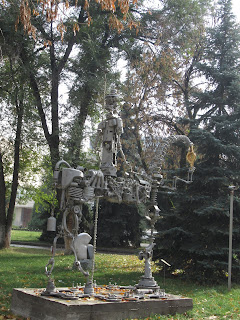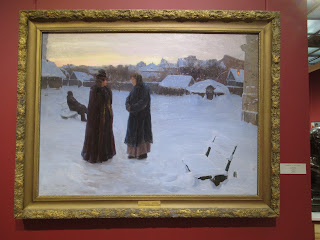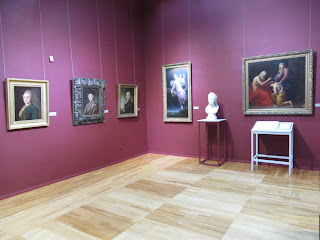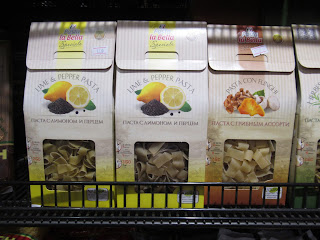After a disappointing time at Almaty's Central State Museum the afternoon before, we decided to give another of the city's museums, the Museum of Arts, a go. Since it was a fair piece away it meant also trying out the city's metro system.
The plastic metro token looked far more substantial than the blue translucent one used in the Uzbekistan capital city of Tashkent.
There was a constant barrage of announcements, or should I say admonishments, on the long ride down to the platform: Don't lean on the escalator, don't sit down on it, don't play on it, don't put bags on the steps, don't leave belongings behind, refrain from wearing headphones, etc! There was enough time to listen to them in both Kazakh and English several times as the ride was so long.
It was impressive seeing a lift available for those needing assistance up or down the stairs as that wasn't something we see often in other cities.
What a difference a day made in terms of warmer weather exploring more of Almaty. The city's Drama Theater named after Mukhtar Auezov, a Kazakh writer and social activist:
Across from it was the Circus Building that looked just like a circus tent. We checked to see if the circus might be in town as we would like to have seen a performance but we were out of luck. It was fun to see the sculptures in the pool in front of the building, though.
We smiled seeing the ferris wheel as it seemed we'd seen one in almost every city and small town in the former Soviet Union!
More sculptures outside the Kazakhstan Museum of Arts, our destination all along:
I was curious to see what the exhibits inside might be like as the exterior looked very drab.
Never had we seen such a pretty 'Oriental' carpet in a museum lobby before.
Strangely enough, just off the lobby was a shop selling carpets.
Sculptures in the lobby:
Luckily there was no issue about anyone taking photos at the Museum of Arts compared to its sister museum we'd been to the day before, the Central State Museum. I wish I knew why some museums have a no photo policy and why.
The Ethnology Gallery was top notch, beginning with a superb collection of Kazakhstan carpets. This felt one was from the 1930s and would have been used in a yurt.
These strips for fastening yurts were also made in the 1950s. When we stayed in yurts in Kyrgyzstan earlier this trip, we had never seen such vibrant colors.
This felt case was used for bedding. We also saw ones to carry dishes used by nomadic people.
Look at the marvelous detailed stitching.
A woven wool saddlebag from the 1950s:
One of the most ancient types of Kazakh applied art, invented by nomads of Central Asia, is hand weaving. Pileless, smooth carpets were very popular in Kazakhstan.
A display indicated that a central place was assigned in Kazakhstan yurts to embroider carpets "which, by tradition, occupied the honorable place and symbolized family happiness and prosperity."
Wooden items from 1975:
The 19th century cupboard was made from wood and inlaid bone.
A popular Kazakh proverb is "A good steed is a horseman's wing." Horse riding accessories were typical features of nomadic life. A good horse and saddle decorated with carved silver and gold were always the symbol of masculine honor, dignity and social status. Saddles and girths were covered with stamped leather and decorated with enamel and inserts of precious and semi-precious stones.
Widespread was golden embroidery on men's outerwear.
A woven velvet chest:
Woven covers for beds were embroidered using golden threads and then put in a chest with its own lovely cover.
In the middle of the Ethnology Gallery was an extensive collection of mostly silver jewelry. A display indicated that jewelry represented the high technical level of craftsmen and the different republics or areas within the country. Jewelry initially performed a function of talismans and protection and later "imparted elegance and cosmopolitan completeness to a woman's holiday costume!"
19th century matchmakers' rings in the foreground and bracelets in the background:
The kobyz was a 19th century instrument made of wood, leather, metal and inlaid bone carving.
As great as the English language signs had been in the Ethnology Gallery, they didn't carry over to the rooms with the paintings where none were in English.
Signs like this didn't help us. What did the date mean, too, I wondered?
Steven liked this image so much he installed it as the desktop picture on the mini computer I use to write these posts so it's the first image I see every time I turn the computer on. I am surprised it's not yet given me nightmares!
There was an exhibit of approximately 70 paintings, sculptures and objects from the museum's collection of 16th to 19th century Western European Art.
I loved how the children seemed to just jump out of this 18th century Dutch oil on canvas.
This 18th-19th century French clock with a figure was made of bronze and fire gilding. Imagine having this on your mantelpiece!
What a delight it was coming across this gallery with good lighting, attractively painted walls and impressive art. It looked like it would have passed muster in any European city and not in a museum in Central Asia. It was the first museum of this caliber we'd come across in a long, long time this trip. The exhibits at the similar arts museum in Tashkent, Uzbekistan, we'd just seen had been very, very good but the displays, lighting, etc had been very poor.
There was a significant collection of Russian paintings.
I could feel the sense of absolute abandonment the artist portrayed with this child.
I enjoyed the section on revolutionary art as we normally see so little of that type of art.
The wood bust of a Kazakh Collective Farmer was done in 1932.
Heroes of the First Five Year Plan was painted in 1936.
Bust of a Taxi Driver from 1964:
The 1930 oil painting Dunya, the Tractor Driver reminded me of the US's Rosie the Riveter!
There was a large collection of wonderful paintings by Kazakh artist Abylkhan Kasteev who depicted landscapes and scenes of Soviet progress - railways, collective farming, etc - while still towing the party line.
One of the most touching moments I have ever experienced in a museum was seeing and touching literally one of Kasteev's painting that had been made into a 3D form of it for those with sight issues. Why don't other museums commit to doing the same thing?
A Braille copy of the preceding painting made me wish other museums also had Braille paintings to try and convey the beauty of art to those with sight issues.
A painting of Kasteev, known as the people's artist, who lived from 1904-75:
An entire gallery was devoted to paintings by Kasteev. I had been looking for his works for over 90 minutes and was so happy to finally stumble on so many of the celebrated artist's works.
The museum also had a spectacular tapestry collection.
I was totally astounded by how much I enjoyed the Museum of Art in Almaty, even though I admit to having pretty low expectations initially. The Ethnology Gallery exhibits were the best of any museum we'd seen this trip and the detailed background information helped to put what we were seeing in context. The collection of revolutionary art and especially Kasteev's works were the icing on the cake for me!
It seemed only fitting that the last sculpture we saw was of Kasteev as the museum was dedicated to the celebrated Kazakh artist.
A view of the snow-capped Zailiysky Alatu Mountains:
When I saw the sign, I initially thought it meant 'Big Brother' might be watching but later realized, to my chagrin, it indicated there was a blind person living nearby.
While walking toward the Russian Orthodox Cathedral, we passed a slew of sports clubs. I thought it interesting that the 'symbol' for the wrestling one had two black figures out front as the number of black people in Almaty was very, very low from what we'd seen.
It was so nice seeing so many benches in the small, leafy Park Baytursynov unlike Uzbekistan's capital city of Tashkent which had lovely parks but scarcely any benches!
In the park was a memorial to those who perished at the Chernobyl nuclear plant on and also after April 25, 1986. Many of the Kazakhs who were sent to help in the relief efforts also died of later health complications.
Kathy and Colin: I'm sure you both also would have been so impressed with the huge playground that had separate age-appropriate areas. I liked the fact there was also a swing set for adults to use, something I've not ever seen before in the US.
Through the trees we could just see the Russian Orthodox St. Nicholas Cathedral which had been our goal since leaving the Art Museum about an hour earlier.
Access to the Cathedral was via a footbridge from the park!
The very impressive structure with ornate gold domes was built in 1909. It was later used as a stable for Bolshevik cavalry and later by the Soviet regime for non-religious purposes before being re-opened about 1980.
As we neared the entrance we could hear chanting and singing, indicating a service was being held so walked quietly in.
There was the very traditional background of relics and icons as we expected but the sense of peace was palpable as we listened to the priest and watched as people repeatedly made the sign of the cross and intermittently kneeled as is customary during a Russian Orthodox service.
Throughout the service, an almost hidden choir of just five people sang like angels.
En route back to our guesthouse:
Rarely have we witnessed such a disparity of wealth vs poverty on one corner as we did here: the building below would have done Fifth Avenue proud while the building immediately opposite it was an ugly Soviet-era building that looked like it was about to collapse.
We both liked the traditional wooden architecture of this building.
For a good while we had walked past many very high-end shops, bustling restaurants, cafes and bars. It was the first time we'd seen the sign of so much wealth in Almaty. This arcade led us to a very posh specialty foods shop that had a vast array of beautifully packaged items that would have been out of the price range for the majority of residents in Almaty.
Out front, chefs were selling freshly prepared items ready for takeout, something we'd never seen before.
Another modern and architecturally pleasing building that was again so unlike what we'd seen when we first visited Almaty.
Lil Red: Bet you'd have liked this bench as much as we did in front of the many small parks we saw on our walk 'home.' The bench wasn't only supposed to be utilitarian but a work of art as the 'bench sculpture' was called Against the Flow. It was made of wires, circular tube, colored plastic panels and car paint! I wonder if we'll ever see a bench sculpture again?
The statue honored Dzhambul Dzhabaev, a Kazakh poet and singer who gained renown during the 1930s folk revival.
The Almaty Opera House was a lovely looking building in the very upscale part of the city we'd unintentionally but happily happened on while making our way back to the guesthouse.
How's your knowledge of Cyrillic? Did you figure out the sign was advertising an upcoming performance of Don Quixote?!
Throughout this part of the city, there were statues galore. I didn't check out who this dude was, though! When I searched Google for the image, it just came up as 'spruce' so that wasn't very helpful! It was getting late in the day or otherwise we'd have taken time to relax in one of the many pedestrian paths that looked so inviting to sit a spell.
More distressingly ugly apartment blocks were the backdrop to the monument celebrating Zhambyl Zhabaev, a Kazakh folk poet and singer who died in 1945 at the age of 99.
We figured we must have walked about five miles by the time we returned to our little abode in Almaty after visiting the Art Museum, the Russian Orthodox Cathedral and many, many parts in between. Our mini suite in the guesthouse had just about everything we could ever imagine having except for a kitchenette. The hosts had even thoughtfully provided full size toothbrushes, toothpaste, a full sized bar of soap and oodles of Q-tips in addition to the standard lotions and potions!
Posted on November 16th, 2018, from Madrid, Spain.















































































































































So was the metro slow as a snail?
ReplyDeleteNo, luckily, it wasn't that slow but certainly a far cry from the one in Tashkent, Uzbekistan, when we ever only had to wait a couple of minutes between trains!
ReplyDelete